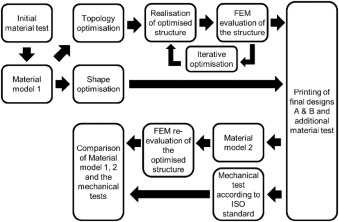In a paper entitled “Mechanical performance of polymer powder bed fused objects – FEM simulation and verification,” a group of researchers discusses the importance of accommodating anisotropic behavior in 3D printed objects. Geometrical optimization is needed so that the object meets pre-set strength and quality requirements. For the study, a material description for polymer powder bed fused or selective laser sintered PA12 was investigated using the Finite Element Method (FEM).
Test specimens in the shape of dumbbells or dog bones were 3D printed, and material tests were carried out. The model was then used to simulate and predict the mechanical performance of SLS 3D printed lower leg prosthetic components: a pylon and a support.
“It was found that the FEM simulations, together with the Material Model, gave good estimations for the location of a failure and its load,” the researchers state. “It was also noted that there were significant variations among individual SLS printed test specimens, which impacted on the material parameters and the FEM simulations. Hence, to enable reliable FEM simulations for the designing of 3D printed products, better control of the SLS process with regards to porosity, pore morphology and pore distribution is needed.”
Two parts of a lower leg prosthesis were 3D printed: a pylon and a support. For the FEM analysis, ANSYS software was used. Topology optimization was carried out to find the optimal geometry of the two parts.
“For topology optimisation, the two load cases were created and linked to a topology optimisation module,” the researchers explain. “Since the topology optimiser cannot handle non-linear effects, the behaviour of the linear elastic anisotropic material together with the analysis of the small deflections was used in this stage. The goal of the optimisation was set to minimise the mass.”
The pylon was investigated first, and was then tested in load case II, according to an ISO standard. The test results were compared with the FEM simulations. The second object investigated was the support. FEM analyses and the optimization of two different designs were carried out: topology optimisation for the vertical and horizontal printing directions of a support with a wall thickness of 7 mm, and shape optimisation of the wall and base thickness of the support printed vertically, based on the existing geometry.
The pylons were horizontally and vertically 3D printed and tested in load case II, combining compression with the bending and twisting of each part. The test results were compared with the FEM simulations, and the two corresponded well. The supports were then tested and the results compared to the FEM simulations.
“It was shown that the Material Model gave a good prediction of the location of a failure and it even yielded reasonable estimates of the loads at failure when tested, according to ISO Standards. Hence, an FEM simulation can be a useful tool, when it comes to the optimal design of 3D printed objects and in predicting how they perform mechanically,” the researchers conclude. “Nevertheless, it needs to be considered that there may be large variations among 3D printed pieces, including dog bones, from which the mechanical properties were obtained or derived. The variations in the material properties (inputs to FEM simulation), e.g. Young’s modulus, yield limit and tensile strength etc., could possibly make an FEM simulation less reliable. Therefore, it is essential to have better control of the 3D printing process, which leads to reduced porosity and a variation in the 3D printed objects, in order for an FEM simulation of 3D printed objects to be reliable.”
Authors of the paper include Anders Linberg, Johan Alfthan, Henrik Pettersson, Göran Flodberg and Li Yang.
Discuss this and other 3D printing topics at 3DPrintBoard.com or share your thoughts below.
